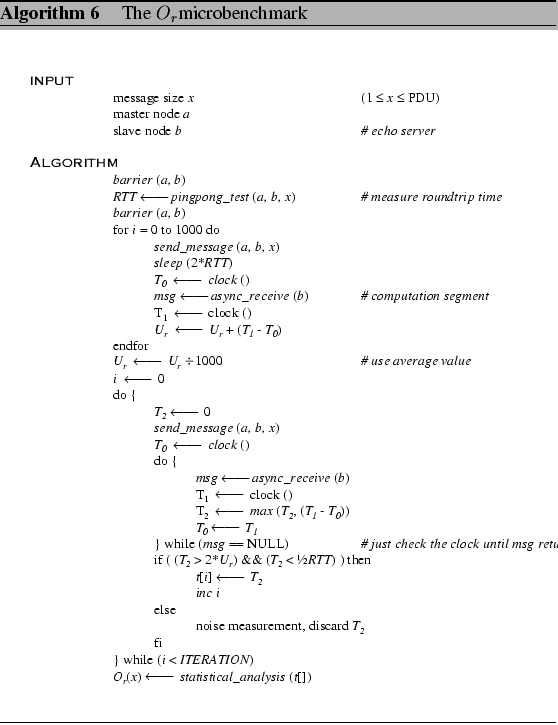In our model, the arrival of data packets from the network is an asynchronous
event, and therefore, we cannot directly probe the source code for
measuring the software overhead associated to the reception event.
Consequently, we have to rely on indirect probing. Observe that without
the support of programmable network co-processor, dispatching of arrived
packets has to be carried out by the receiver host processor. This
is because of the protection reason, moving data across address spaces
should be handled by privilege process only. As the host processor
is engaged during message reception, other execution flows would be
affected. Based on this observation, consider if we know about the
expected execution time of a particular computation segment. And on
a particular run of this computation segment, there is message reception
happened in the background, we would expect to observe a remarkable
increase in execution time. Thence, we have devised a technique to
indirectly measure the software overhead associated to any message
reception. In summary, Algorithm 6 presents the pseudocode
for our ![]() microbenchmark.
microbenchmark.

Our technique to measure ![]() is quite straightforward. As
we need to detect whether a message (packet) has arrived, we have
to poll for the data arrival. Thus, we use the polling action to be
the computation segment. However, if the software overhead associated
to this receive call is too large, we should devise other lightweight
computation segment. First, we have to measure the expected execution
time of this computation segment, as well as the round trip time for
current message size. In our pseudocode, we just take the average
of these measurements, but we can adopt stringent statistical test
to get more accurate value. Then we run another pingpong-like test
to obtain a set of
is quite straightforward. As
we need to detect whether a message (packet) has arrived, we have
to poll for the data arrival. Thus, we use the polling action to be
the computation segment. However, if the software overhead associated
to this receive call is too large, we should devise other lightweight
computation segment. First, we have to measure the expected execution
time of this computation segment, as well as the round trip time for
current message size. In our pseudocode, we just take the average
of these measurements, but we can adopt stringent statistical test
to get more accurate value. Then we run another pingpong-like test
to obtain a set of ![]() measurements. After the master node
sends out one message, it immediately evaluates how long has the host
processor been engaged in polling for message arrival. It records
the maximum time spent in each run until it receives a message. To
filter out noise measurements, we use our baseline measurements to
select possible candidates. This pingpong-like process is running
for many times until we obtain a sufficient large sample size. Then
the collected dataset is processed by some statistical routine to
extract the information we need.
measurements. After the master node
sends out one message, it immediately evaluates how long has the host
processor been engaged in polling for message arrival. It records
the maximum time spent in each run until it receives a message. To
filter out noise measurements, we use our baseline measurements to
select possible candidates. This pingpong-like process is running
for many times until we obtain a sufficient large sample size. Then
the collected dataset is processed by some statistical routine to
extract the information we need.